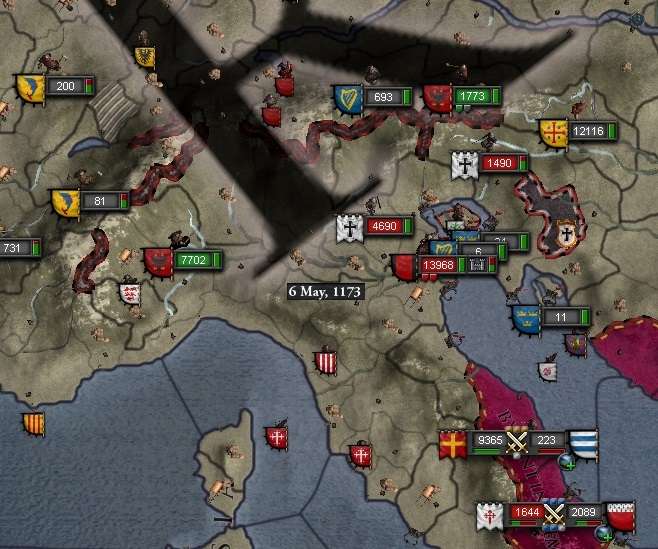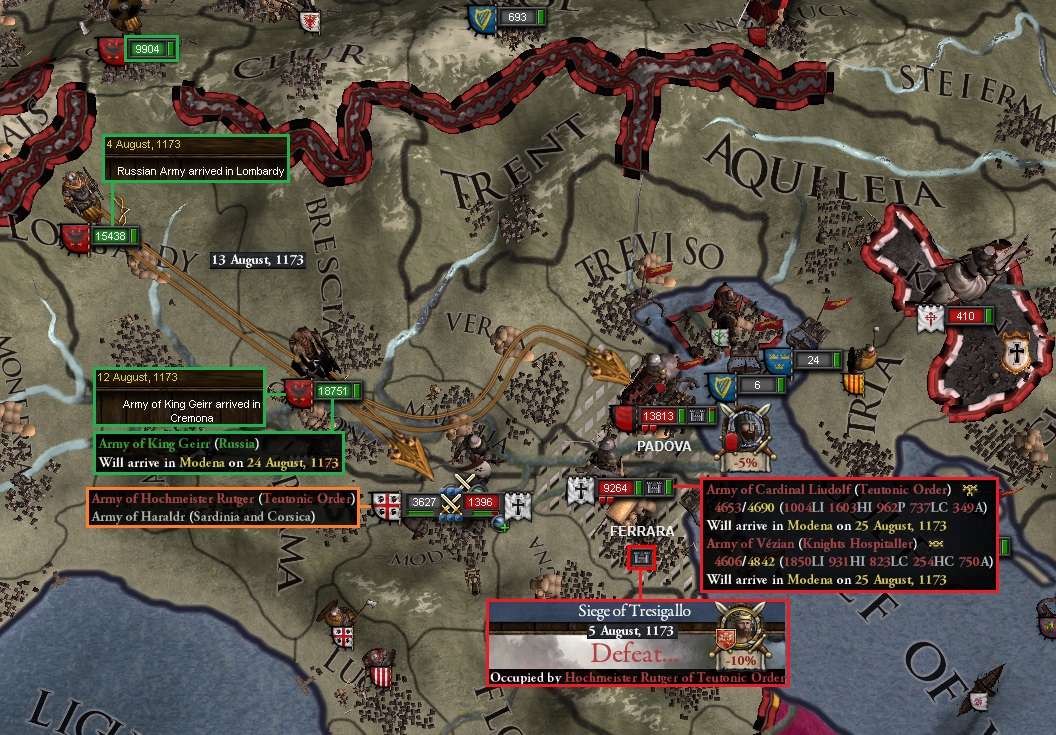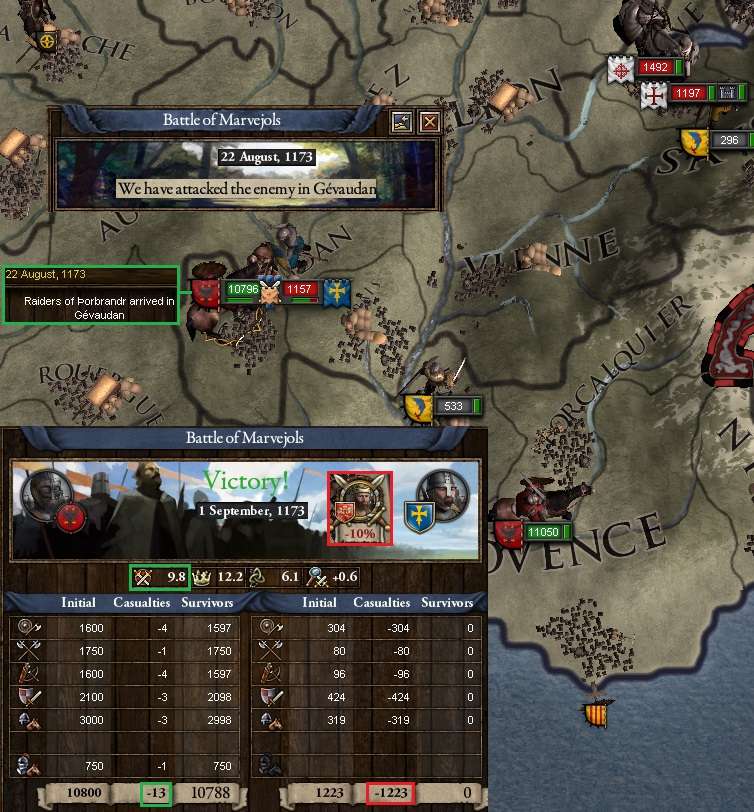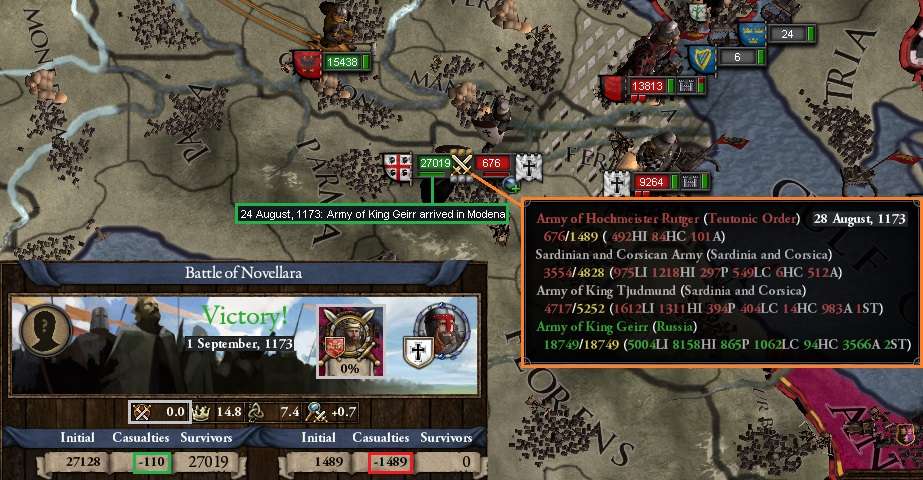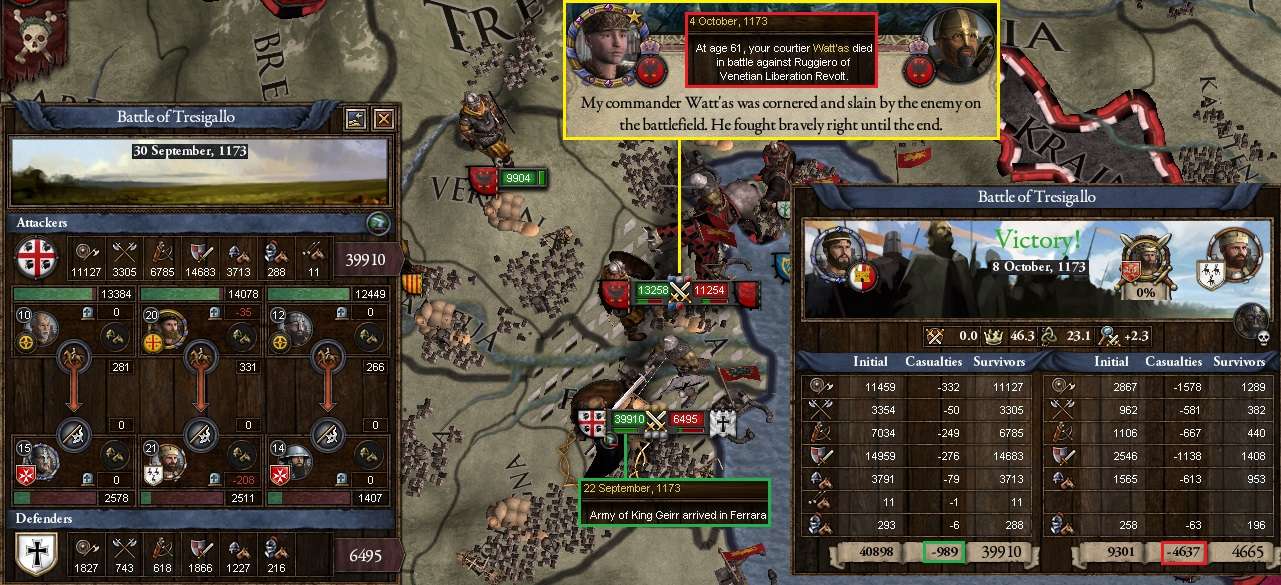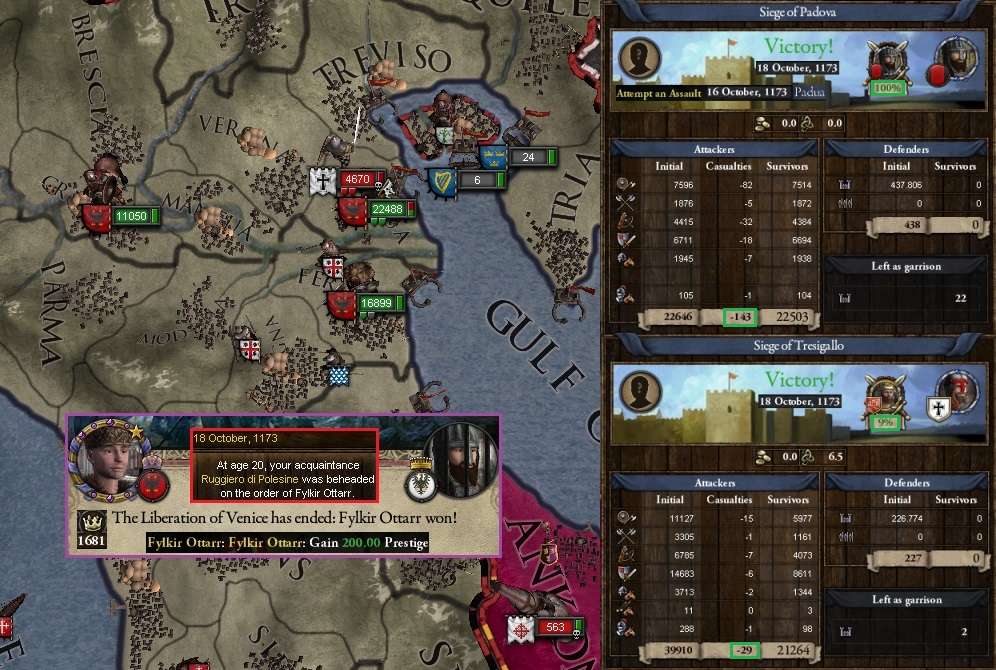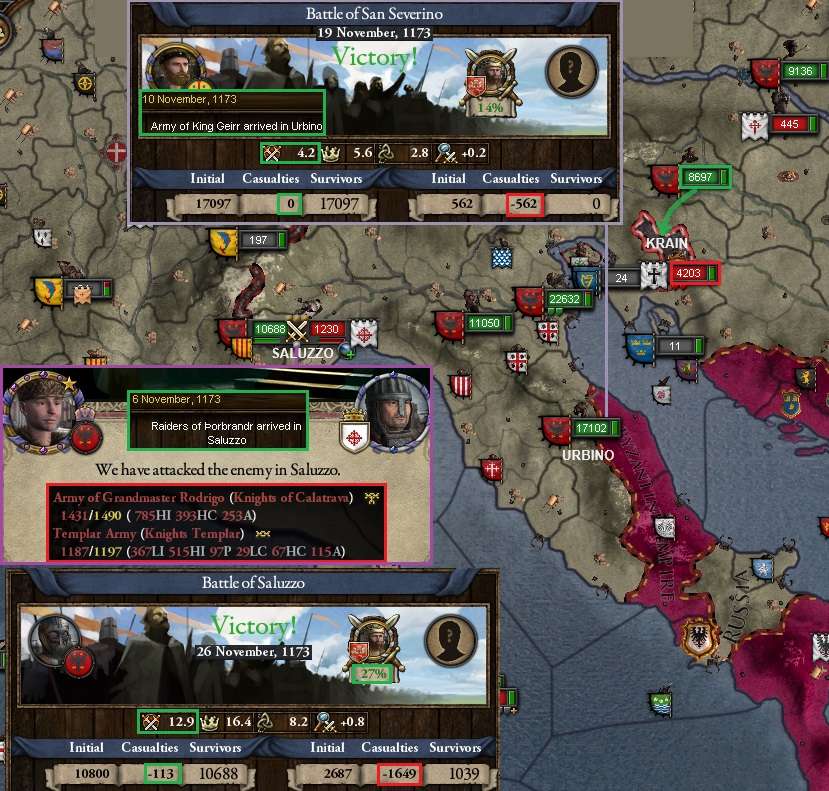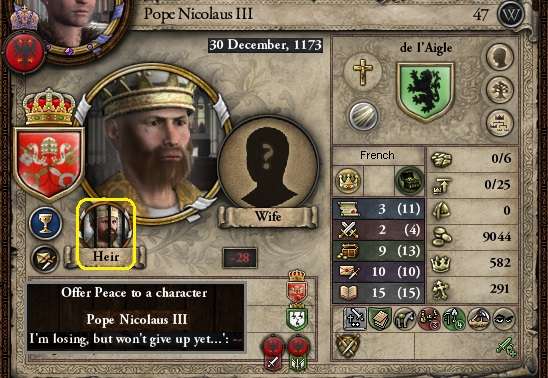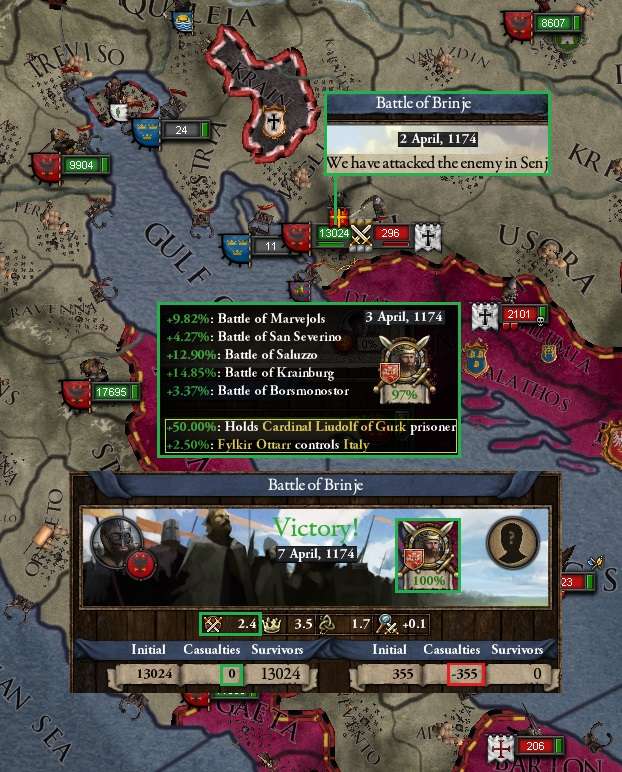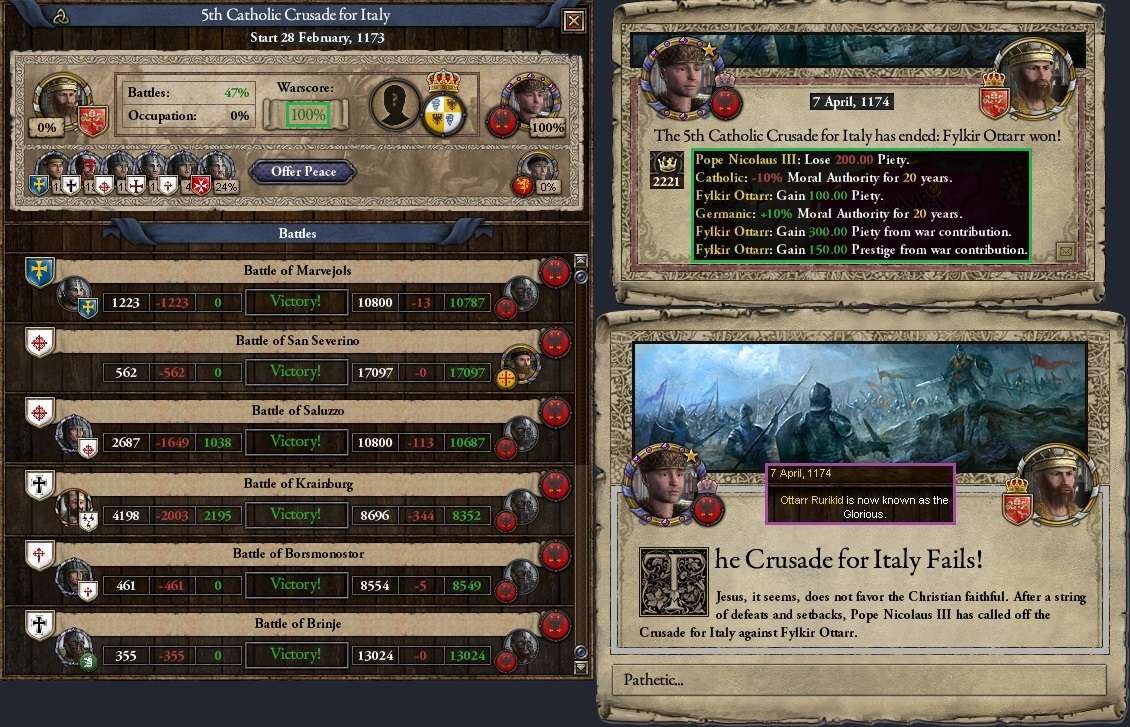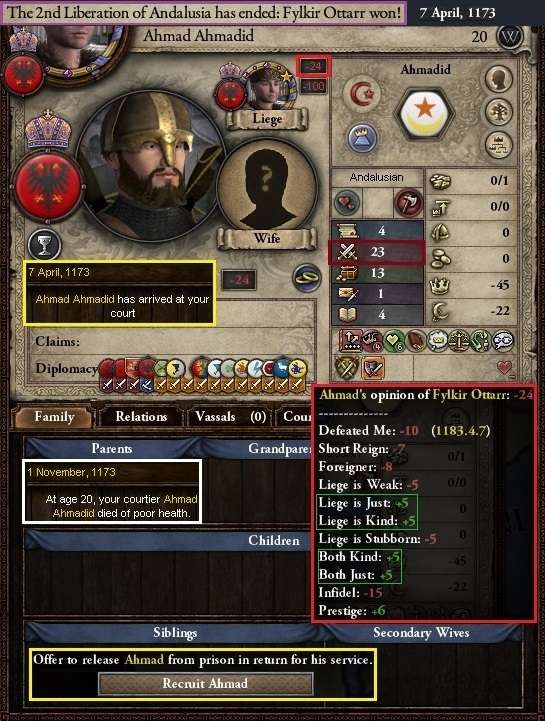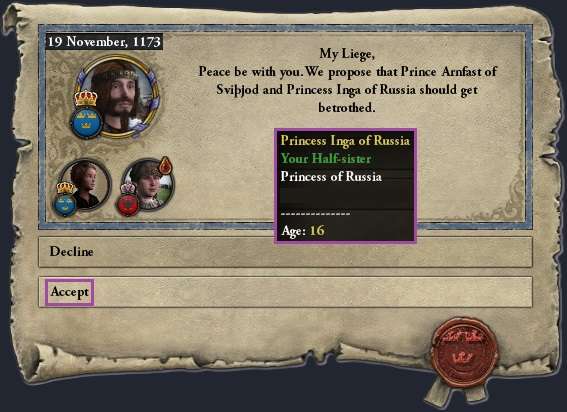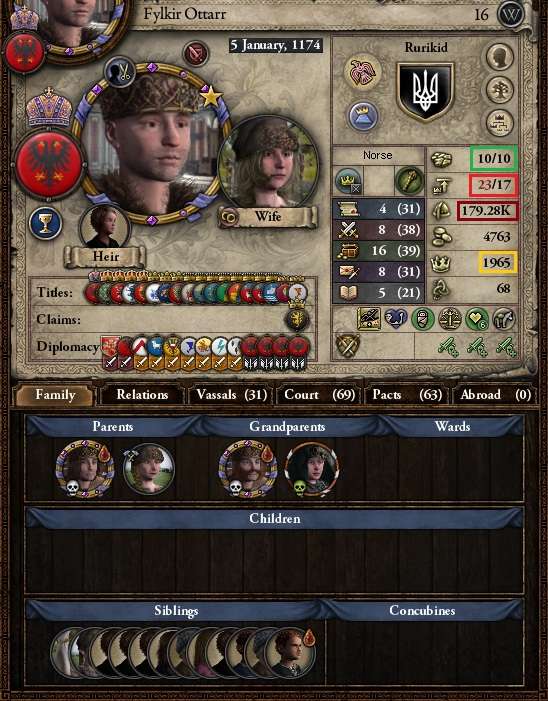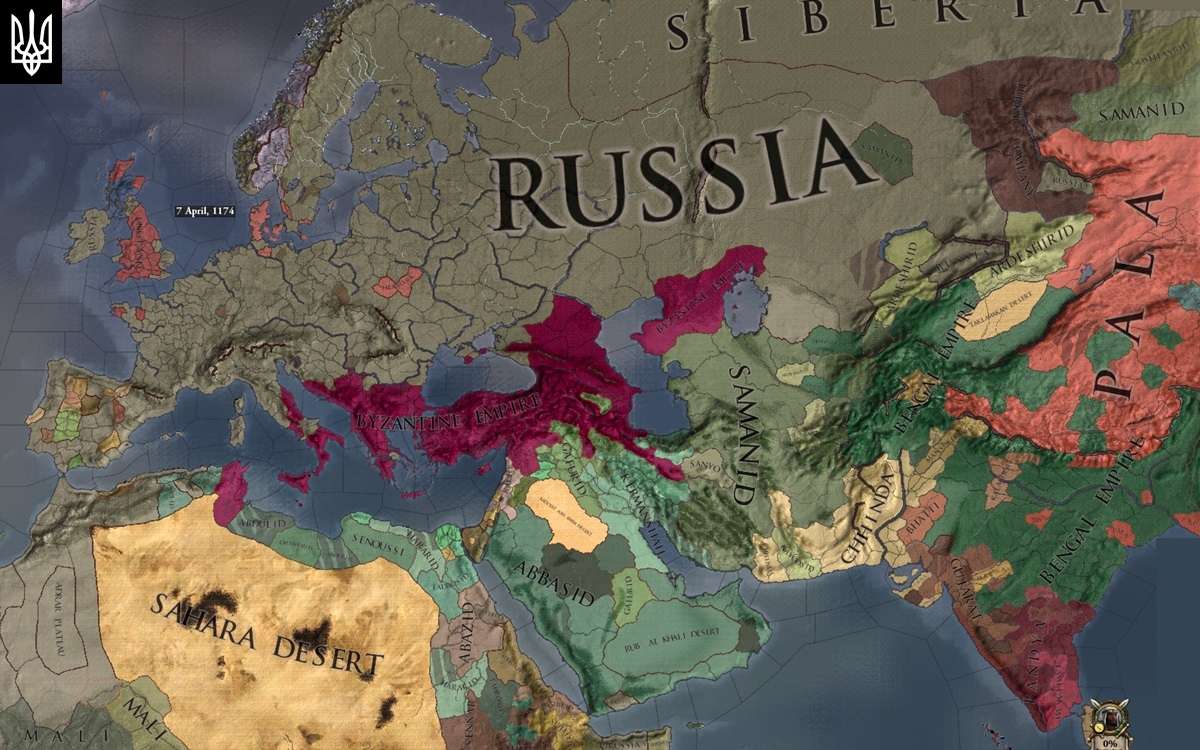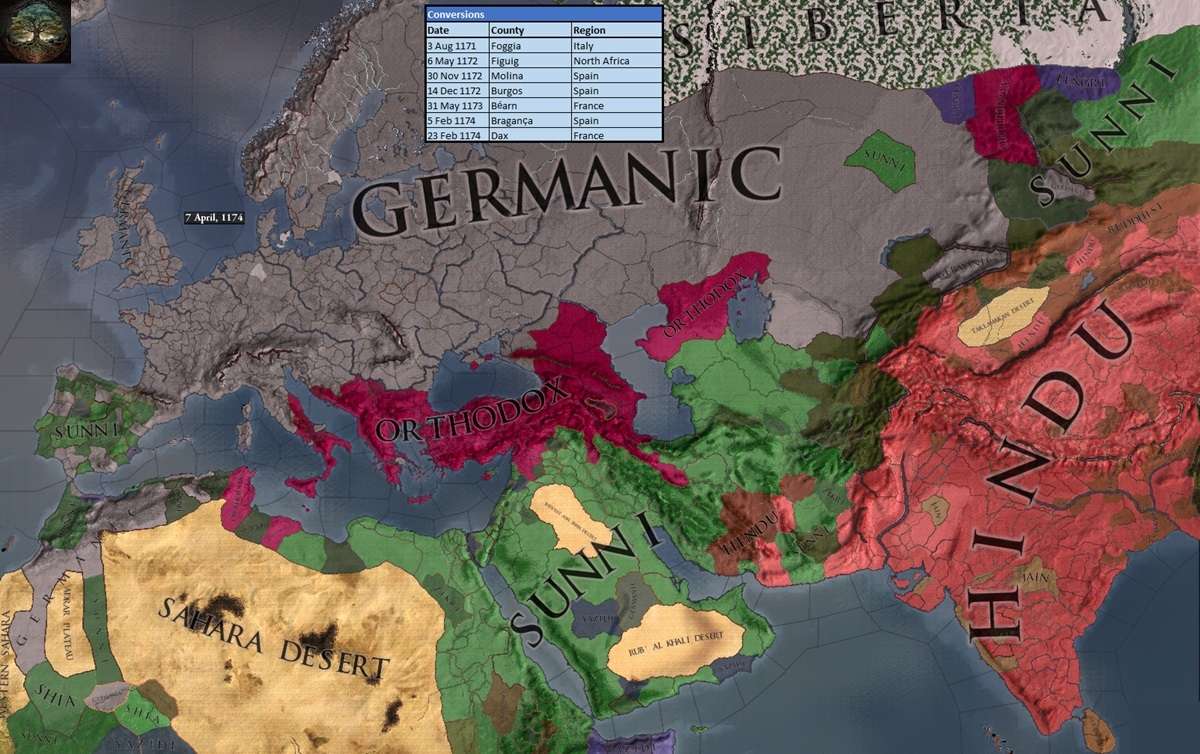Chapter 58: Glory and Anguish (May 1173 to April 1174)
ᚔ ᚱᚢᚱᛁᚲᛁᛞ ᚔ
Recap
Early 1173 had been a rather tumultuous time for the Rurikids. Even as a large Andalusian Liberation Revolt was being dealt with, almost 14,000 Venetians had risen in another liberation revolt on 1 February, followed by the declaration of the 5th Crusade for Italy by Pope Nicolaus III on 28 February. Then on 2 April, the seemingly all-powerful Emperor Toste III had died unexpectedly to be replaced by his somewhat underwhelming son Ottarr, who had only come of age a month before.
The Andalusian Revolt was defeated just five days after Ottarr’s elevation to the crowns of the Fylkirate and Empire. In the meantime, the twin threats of the Venetian Revolt and the 5th Crusade (relying entirely on the Christian religious orders) had seen two large bodies of enemy troops concentrated in north-east Italy while Rurikid forces needed to be assembled and brought to bear to counter them.
ᚔ ᚱᚢᚱᛁᚲᛁᛞ ᚔ
The Italian Wars: Preparatory Moves, May-August 1173
By 6 May 1173, the rebels had made good progress in their siege of Padova, while a good-sized Teutonic army moved around them – ultimately bound for Ferrara, directly to its south.
In response to this, Ottarr mustered the relatively nearby vassal levies of the Kings of Germany and Lotharingia, the Jarl of Savoy and the Jomsvikings: around 44,000 troops in total. They and the Imperial Guard and demesne levies already mustered would head to northern Italy and the still ex5tant peasant revolt in Altmark to bring order to the somewhat turbulent situation Ottarr’s early reign had inherited.
Those troops began to approach the front by mid-July but were too late to prevent the rebels taking the main castle of Padova on 12 July, as the Crusaders continued to concentrate in Ferrara.
In southern France, the two main Guard armies were emerging from Spain as both they and three smaller Crusader forces all homed in on northern Italy.
On 4 August, the large Lotharingian levy army crossed the Alps into Lombardy. A day later, Tresigallo fell to the Crusaders in Ferrara, led in person by Cardinal Liudolf (Pope Nicolaus’s designated successor). King Geirr (one of Ottarr’s Imperial Commanders) commanded a larger force that arrived in Cremona on 12 August.
By 13 August the Lotharingian levies were directed to attack the rebels in Padova, while Geirr marched to assist a Sardinian-Corsican army (the Crusade had been launched for their subordinate Kingdom of Italy) skirmishing with the Teutonic Knights in Modena. Word had come that Cardinal Liudolf was preparing to raise his siege in Ferrara to reinforce Modena as well.
Before that battle began, a small Crusader army was unfortunate enough to be ambushed by a far larger Imperial Guard army (still deliberately left in raiding mode) under Þorbrandr at Marvejols in Gévaudan. The whole Crusader force was wiped out by 1 September for minimal Russian casualties.
By 24 August, Geirr had joined the Sardinians at Novellara in Modena, who had also reinforced. The Lotharingian levies were passing to the north on their way to Padua. By 28 August the battle was already over and Cardinal Liudolf had halted his own army to recommence his siege in Ferrara. The Teutonic Order force in Modena had been completely destroyed.
The Italian Wars: Main Clashes, September-October 1173
Both wars now entered their decisive phases. On 10 September the Lotharingians, now commanded by Sigtrygg, struck the Venetian rebels in Padua in a numerically fairly even fight.
Four days later, the two quicker-moving contingents of the Sardinian army had attacked the Crusaders in Ferrara as both Imperial and more Sardinian forces followed them up.
On 22 September, King Geirr’s army and the rest of the Sardinians had joined the battle at Tresigallo in Ferrara and by the 28th the Crusaders had been crushed by this force of almost 40,000 Norsemen. The pursuit would be fully concluded by 8 October. Again, this counted as a win for the Sardinians but it meant the main Crusader army had been rendered ineffective.
Meanwhile, in Padua the fighting was more even as both sides tired. More Russian reinforcements were on their way from the north-west, but on 4 October the distinguished Rurikid General and Court Tutor Watt’as fell in combat.
The Russian reinforcements duly arrived in Padua on 9 October, in time to join the pursuit and this was of the remaining rebels as they fled the field. This fight had been far more even but the rebel cause was now badly damaged. However, the war went on: Padova would have to be retaken and it would take three days for the Russians to prepare to storm the walls against a small rebel garrison.
In Ferrara, the Sardinians commanded the siege, so any assault there would have to be conducted under their orders. One of the Guard raiding armies arrived in Cremona at the same time but would not be needed for these sieges: they would wait and if necessary respond to any Crusader contingents that made it over the Alps into northern Italy.
‘The Battle of Padua’, painted by an unknown Rurikid court artist circa the mid-16th century, showing the final Russian charge that swept the determined rebels from the field.
In the event, the assaults would go ahead at the same time, both ending on 18 October. The retaking Padova saw the Venetian rebellion defeated and its leader beheaded, with the victory considerably boosting the young Fylkir’s prestige.
The Crusade would go on and would have to be defeated by other means, given the Pope did not control any home territory that could be occupied. It looked like a long and laborious process of picking off small Crusader armies would be required.
ᚔ ᚱᚢᚱᛁᚲᛁᛞ ᚔ
The 5th Crusade: Mopping Up, November 1173-April 1174
These mopping up actions commenced in November 1173, with Þorbrandr chasing down a combined Calatravan and Templar army at Saluzzo. They would be defeated after 20 days. A smaller action was fought down in Urbino with a small Crusader regiment wiped out in just 9 days from 10-19 November.
By that time, the main Templar army under Cardinal Liudolf had rallied and re-formed at their base in Krain. Another Russian army was closing in on them from the north-east.
General Tyke took control of that levy army, which attacked Cardinal Liudolf at Krainburg on 3 December. The fighting did not finish until 30 December, producing a major victory on the battlefield – and an even larger diplomatic triumph.
The Cardinal was captured during the final stages of the pursuit, his captivity suddenly bringing the end of the Crusade into site, as the ‘Shadow Vatican’ was clearly desperate to get the Pope’s heir back safe from the clutches of the Evil Emperor Ottarr.
But Pope Nicolaus was not yet quite desperate enough nor horrified at the continued slaughter of Crusader armies to capitulate. He seemed to be hoping for some kind of miracle, despite the seemingly obvious (to the Norsemen, anyway) proof that their Old Gods were the stronger on the battlefield.
Mid-February 1174 saw another small Crusader contingent tracked down and wiped out at Sopron, as they fled through Hungary
[95% warscore]. At that late stage, Old King Gandalfr of Noregr – despite not getting on with Ottarr – offered to join the defence against the Crusade. The diplomatic nicety was accepted with the same cool politeness. At least it was a fair gesture.
The last action of the 5th Crusade was the smallest of all, with a company of Teutonic Knights surprised and destroyed during a skirmish outside Brinje in Senj.
That, plus the continuing full control of Italy by Ottarr, was the final straw. Pope Nicolaus finally acknowledged the inevitable on 7 April 1174. The prestige of the young Fylkir was rising rapidly, which would help to further cement his early reign. And this latest glorious triumph saw Ottarr acquire an early and very complimentary nickname.
While his adversary reputedly implored the heavens to ask the classic question: “Oh God, why hast thou forsaken me?”
“The Anguish of Pope Nicolaus” by the Norse-Italian painter Helgi Caravaggio, c. 1600.
ᚔ ᚱᚢᚱᛁᚲᛁᛞ ᚔ
Vassal and Foreign Affairs
Smaller vassal internecine and border wars went on through 1173. In October, King Gnupa of Irland won another big victory against ‘Western’ Mali, slicing two more counties from Farbas Musa’s shrinking domain.
Then in January 1174, there was another defiant but daft attempt by Caliph Bannu of ‘Eastern’ Mali to reclaim lost lands. An suitably insulting declaration of war was issued, both its words and futility causing some merriment in the Rurikid court when it was received.
With the end stages of the 5th Crusade still dragging on and Rurikid forces concentrated in Italy, two more vassal levy contingents were called out a few days later, the bulk of which would be provided by Jarl Folki II of Dauphine. They began their long march south.
In March 1174, two more counties fell to Russian marcher lords in quick succession. The first, for Faro, had not been tracked with the county going to a ‘third level’ vassal, Hrolfr of Seville.
Ten days later Jarl Falki of Hlymrek expanded his Spanish holdings further with the conquest of Shlib (now known as Silves) after a little less than two years of fighting.
ᚔ ᚱᚢᚱᛁᚲᛁᛞ ᚔ
Court and Domestic Affairs
Back in April 1173, Ottarr had entered a betrothal arrangement with the most eligible young woman of similar age available at the time. Skuld Totilsdottir Hede of Göttingen would turn 16 in December 1173, so Ottarr had around six months to wait before he could conclude the marriage bargain.
In July 1173, the peasant revolt in Altmark ended after a passing Swedish army defeated the rebels in Werle, less than two weeks after one of the designated Imperial army had arrived in Altmark to retake the rebel-occupied castle. Ottarr’s previous (limited) mercy for captured rebels was not extended to the unfortunate peasant leader this time: the ultimate Viking punishment was administered.
The latest Jomsviking Warchief Bo ‘the Unready’, a kinsman of Ottarr’s, died a natural death on 3 July 1173. But the personal loyalty of their realm and Holy Warriors was unaffected.
After the previously noted death of Watt’as in battle against the Venetian rebels, Imperial Steward Bonga ‘the Eunuch’ was appointed to the additional role of Court Tutor on 6 October 1173.
A week later, a new peasant revolt broke out, this time at Don Portage in southern Russia. A contingent of around 9,000 men was sent east from Hungary in case they were needed. But local troops would defeat the rebels in February 1174 without the need for Imperial intervention.
At the end of the Andalusian Liberation Revolt in April 1173, its talented commander Ahmad Ahmadid had been released by Ottarr in return for his pledge of service. But he never got to fulfil that undertaking, dying of some unknown cause of ‘poor health’ just seven months later. So much for the ‘mercy experiment’.
With his new bride not due to arrive until the end of the year, Ottarr’s private journal reveals he began an affair with his relatively young Seeress, Yrsa, in November 1173. This happened while she was off in Dax, bringing Odin’s light to the heathens there.
Relations with Sviþjod were reinforced in November when Ottarr’s agreed to one of his many sisters being betrothed to a young Prince there.
As the year came to a close, the Fylkir’s betrothed was called to Nygarðr. A major event was held on 1 January – a very auspicious day as it coincided with the anniversary of the founding of the Rurikid dynasty. Skuld had blossomed into a talented young lady who advice would add to Ottarr’s statecraft in many areas.
Weddings for sitting Emperors were a comparative rarity and this one was celebrated in high style from Ottarr’s own pocket, further adding to his growing prestige.
With his wedding completed, Ottarr could now retain all ten of his remaining demesne baronies without attracting vassal disfavour. But his span of direct vassal management would need to be further trimmed – something he put off for now.
His troop base remained around 50,000 fewer than his father Toste III had been able to command at the height of his reign, in part because of his inferior military skills. But his prestige was growing and it was still a far larger army than any of his imperial counterparts commanded. That said, it would now be easier for a combination of them – such as that caused by the triggering of a ‘universal pact’ – to match the Rurikids for total numbers.
Ottarr’s journal reveals Gydja Yrsa was still his lover when she managed to personally convert Dax to Reformed Germanicism in late February 1174.
Not much more had changed by early April, just after Fylkir’s 17th birthday and his triumph in the 5th Crusade for Italy and his designation in all subsequent Imperial propaganda as ‘the Glorious’.
A mid-17th century (and clearly romanticised) official Rurikid statue entitled ‘Ottarr the Glorious’, which still stands at the Imperial Palace in Nygarðr.
The temporal Rurikid Empire in April 1174.
The Fylkir’s Reformed Germanic 'Empire of the Spirit' at the same time, noting conversion over the previous three years.





